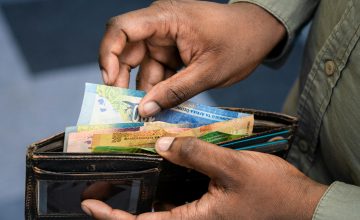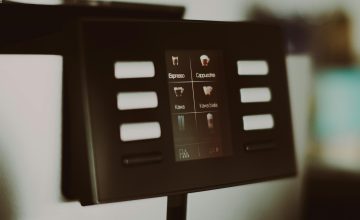Espresso Guide: We reveal the Mystery behind the Perfect Shot
- Aug 29, 2014
- By Michael Harf
- In Coffee Machines - Reviews, Guides and Comparisons
Espresso Guide: We reveal the Mystery behind the Perfect Shot
Espresso is a mystery to most. We provide a bit of an espresso guide to reveal the mystery. Few people really know it, how to make it, or even what it should taste like. Everyone at some point has been lured into a false sense of understanding and information by companies like Starbucks, Nespresso, Krups, and countless other brands looking to make espresso easy and cheap. Don’t fall for it. Espresso, done right, is magical. Here’s how the best work their magic.
What is Espresso?
Espresso is actually a coffee bean roast, not a coffee bean type. Espresso is simply one way way to brew coffee. In fact, any coffee beans can be brewed as espresso — though some methods or types vary greatly in taste.
The basic process to make espresso is to push hot water through a compacted puck of grounds at high pressure, usually at around 9 bar (9 times the atmospheric pressure at sea level). The reason you see coffee bags labeled espresso, is either because its contents are finely pre-ground which is perfect for espresso brewing, or it is a blend that has been crafted to create a balance of flavors when brewed as espresso.
Man & machine – The delicate balance
To brew great espresso, a symphony of events happen to merge human judgment with mechanical precision. The human roaster starts the process – make a blend of different balanced coffee flavour types, or use a single-origin bean that highlights the experience unique to that particular variety?
As you open the bag of beans to prepare a drink, it’s up to you to make sure the beans are fresh, meaning no more than 2 weeks from the roast date, and ground immediately before brewing. Certain aromas in ground coffee evaporate within the first 20 minutes of grinding, so speed is your new espresso taste friend. The grind size varies on the coffee characteristics such as age, bean variety, and roast-profile. Even at the highest levels there are no secret formulas, with adjustments being made according to personal taste. The coffee is then precisely dosed, compacted into a basket, or portafilter, and finally meets the mysterious espresso machine.
Pressure & Heat
All espresso machines contain boilers with heating elements that brings the water to the proper temperature. The shot pressure (to pull the water through) is generated by either a piston (found in older manual machines), steam power (in modern low-end machines), or a motor-driven pump. Commercial machines (found at coffee shops) use a rotary pump that keeps constant pressure, whereas smaller machines use a vibration pump that generates pressure only as the shot is being pulled through.
Stability the the magic keyword for good espresso machines. If there is any fluctuation in heat, even to the tune of a couple of degrees Celsius, it can change the taste of the coffee and make it impossible to pull consistent, high-quality shots. High-end espresso machines maintain heat and pressure during the brewing process using a few key methods and components.
The first component is a double boiler system – which basically means one boiler heats water for the brew, and another heats water for the steam wand. Since each of these two processes have completely different temperature needs—100°C for boiling steam and 93°C for espresso which isn’t quite yet boiling.
The other important mechanism is a PID (proportional-integral-derivative) controller. PID is a generic term for a controller that maintains a set value using control feedback loops. Some common devices that use PIDs are – vehicle cruise control to keep a constant speed. In an espresso machine, the PID maintains constant water temperature to the very degree. This consistency in temperature naturally leads to a consistency in results as well.
Other factors that might influence the choice of a good espresso machine are machine properties like: build quality, longevity, and ability to withstand the rigors of a commercial setting. Metal types used in the boilers, the kind of pre-heating system and whether it is plumbed into your water supply or a reservoir-based water system all contribute to the overall experience and your ability to control the brew.
And the taste of the espresso?
Even the espresso you get from Vida, or from a pod, or in a deli, or even overseas from Starbucks, isn’t even a fraction of what a well-made espresso tastes like. The majority of casual coffee drinkers have never actually had a good espresso coffee shot, so they don’t know what they are missing out on.
Espresso brewed from freshly roasted, freshly ground coffee and made on a commercial machine by someone who has paid close attention to the process, should have a rich and sweet taste. Even though coffees have a flavour profile like fruity, chocolatey, floral, it should definitely never taste burnt, ashy, bitter, or sour. Most blends try to be mellow and appeal to a broad number of people, but you might want to try a single-origin coffee for something completely different. Remember, like wine, it can be an acquired taste. If at first you don’t really like the taste, don’t stop, you’ll get the hang of it eventually. Try and experiment not only at home, but in a variety of espresso coffee shops.
Home Espresso
Making a good espresso at home is full of promises but empty on delivery. You get seduced by the sales promise of a R1000 machine that advertises “up to 15 bars of pressure!!” Typically, these machines lack pressure regulation that maintains the full 9 bars of pressure for the whole shot pull (20-30 seconds). Nespresso and other pod machines are convenient, but do not generally produce quality espresso. Not only do they lack the proper mechanics, but the coffee is of poor quality and of course already pre-ground (even if sealed at the factory).
Get a good grinder – no matter what machine you want to use. Only a good conical burr grinder that produces fine, consistent grounds, that can be precisely adjusted, your R50 000 espresso machine will go to waste. At the lowest end, an espresso-capable grinder will run about R3 000, but many enthusiasts will tell you to spend around R5 000 on something like a Baratza Vario to really dial in precise settings.
Lower cost machines feature only a single boiler, and sometimes they have inadequate steam pressure rather than pump pressure. In this case, you will see wildly inconsistent results, and especially if you are making milk-based drinks, you’ll have to wait in between brewing espresso and steaming milk so that the temperature can recover. Keep in mind, you can achieve good espresso with a quality single-boiler machine that is pump-driven, but it will require a great deal of attention and fiddling to get great results every time. A good one will cost around R6 000. Some coffee DIY hackers even modify their single boiler espresso machines and add in a PID controller themselves. A popular machine for this hack is the Rancilio Silvia.
If you want something more robust, you could consider a machine with a heat-exchange (HX) system. These machines have one boiler, but will allow you to steam milk and pull a shot without delay. They’re still prone to instability in temperature, though, especially if they idle too long. Even so, expect to pay over R15 000 for an HX machine.
Finally, we come to double-boiler (DB) home espresso machines, which are simply the best for a worry-free experience. They usually feature a PID, so you can dial in a shot temperature, and pull many successive shots and steam milk at the same time, that’s consistent and reliable. Until recently, double-boilers machines run you upward of R20 000.
All this for one ounce of coffee?
For the general public coffee, and even espresso, is purely a morning pick-me-up. Obsessing over things like mouthfeel, crema color, and grind size will always seem ridiculous to the vast majority. But once you get that connoisseur taste of a truly remarkable espresso, it’s hard not to seek more and more.
Journeying to coffee shops, each with different beans, machines, and atmosphere is fun, but nothing is more satisfying than bringing the experience home and crafting something for yourself. Still, the best methods remain in pumps and boilers, the age-old mechanics that give us the perfect shot.
Experience a Rental-Free Coffee Machine Trial Now!
Categories
- 10 Reasons Why It’s Better to Rent an Office Coffee Machine
- Affordable Coffee Machines in 2020
- African Coffee
- Aquaspresso
- Automatic Coffee Machine
- Bean to Cup and Automatic Coffee Machines
- Bean to cup vs Espresso Machines
- bean-to-cup coffee machine
- Bean-To-Cup Coffee Machines
- Best Cappuccino Coffee Machines
- Best Coffee Beans in South Africa
- Best Coffee Beans of 2020
- Best Coffee Machine with a Grinder
- Best Dulce Gusto Coffee Capsules
- Best Industrial Coffee Machines
- Best Restaurant Coffee Machines
- Bianchi Coffee Vending Machines
- Bosch Coffee Machines
- Bosch Coffee Machines: Range Overview
- Bravilor Bonamat Coffee Machine Range
- Bravilor Coffee Machines
- Breville Coffee Machines
- Burr Coffee Grinder
- Buying a Home Coffee Machine
- Buying Coffee Machine on Takelaot
- Capsule Coffee Machines
- Cheapest Coffee Machines of 2020
- Choosing the Right Coffee Machine
- Choosing the Right Coffee Machine in 2020
- Cleaning Your Coffee Machine
- Coffee
- Coffee Academy
- Coffee Beans
- Coffee Capsule Brands
- Coffee Machine
- Coffee Machine Battle
- Coffee Machine Buying Guide
- Coffee Machine Dealer List 2019
- Coffee Machine for Home
- Coffee Machines
- Coffee Machines – Reviews, Guides and Comparisons
- Coffee Machines with Milk Frothers
- Coffee Sweeteners
- Coffee Trends 2019
- coffee vending machine
- Coffee Vending Machines
- Coffee/Hot Chocolate Machine
- Coin Operated Coffee Machines
- Commercial Coffee Machine
- De‘Longhi Coffee Machines
- Delonghi Magnifica ESAM3300
- Different Coffee Machine Types
- Dulce Gusto Coffee Machines
- Health
- Health Benefits of Coffee
- How Much To Spend On a Coffee Machine?
- instant coffee
- Jura Bean-to-Cup Coffee Machine Review
- Jura Coffee Machines
- Jura Machine Cleaning Tablets
- Jura vs. De'Longhi
- Keurig Coffee Machines
- Miele vs. Jura
- Mythos Coffee Machine
- Mythos Dealer List 2019
- Nescafé Dolce Gusto Circolo Coffee Machine
- Nescafe Dulce Gusto
- Nescafe vs. Jura
- Nespresso vs. Dolce Gusto vs. Jura
- Office & Commercial Coffee Machines
- Organic Coffee
- Percolator Coffee Machine
- Philips vs De'Longhi
- Powdered Milk
- Price Review
- Review
- Rheavendor Coffee Machines
- Saeco Brand Review
- Saving Money
- Schaerer Coffee Machine
- Starbucks vs. Jura Coffee Machines
- The Best Combo Machine of 2020
- The Perfect Home Coffee Machine
- The Rise of Self-Cleaning Coffee Machines in 2020
- Top 5 Coffee Machine Brands of 2020
- Top Home Coffee Machines
- WMF Coffee Machine Dealer List 2019
- WMF Coffee Machines








